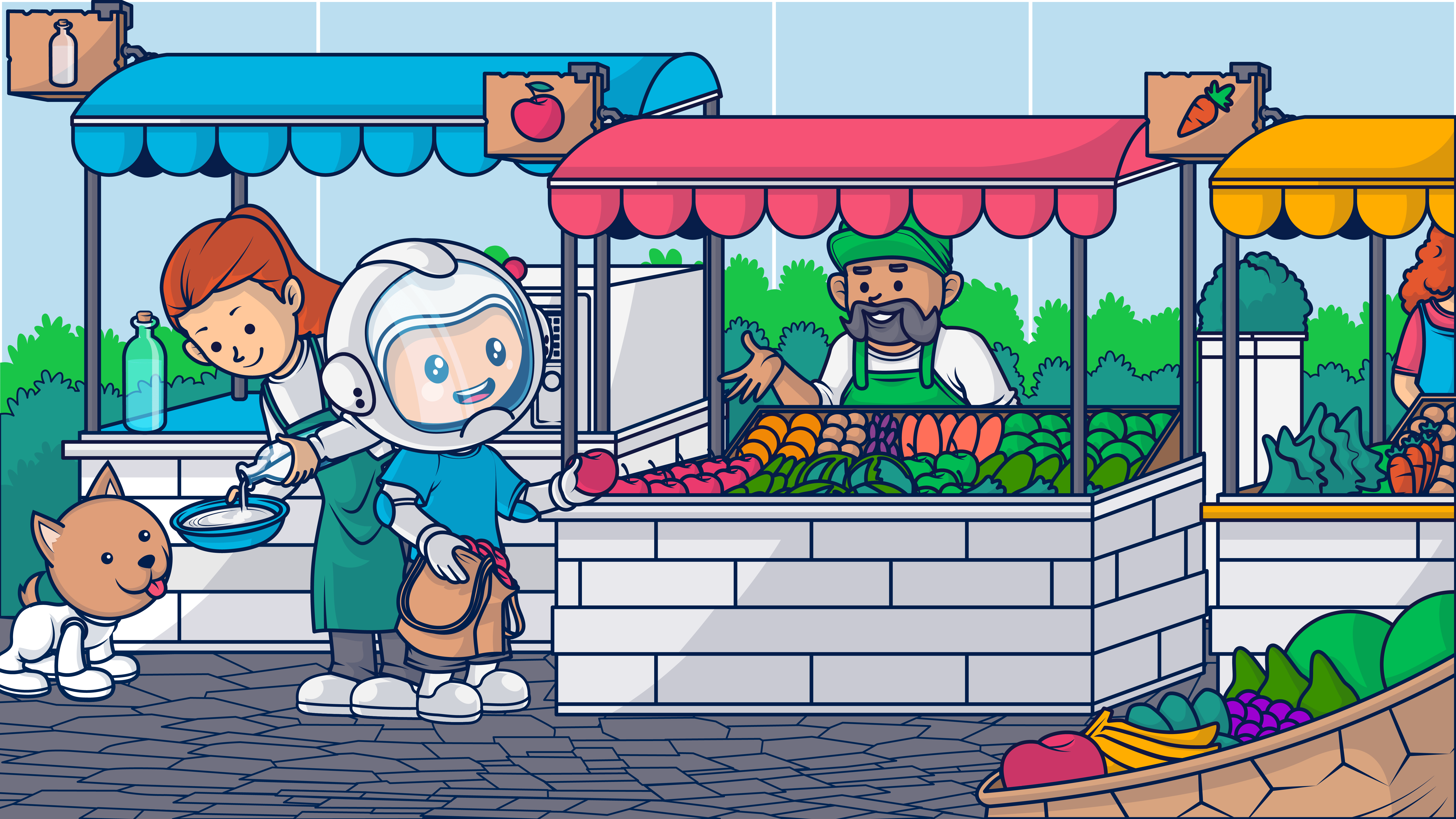An increasing number of consumers are going green and spending their green with brands that share their commitment to a sustainable planet. These savvy shoppers expect brands to communicate with authenticity and transparency about their sustainability practices. How can you promote your brand’s eco-credentials in your email marketing campaigns? Find answers to your sustainable marketing questions here.
Around the world, awareness and concern about climate change, and sustainability have reached new heights. Reports indicate that most consumers want sustainable product and service options and prefer brands that offer them. Yet there remains a gap between attitudes and behaviors.
This gap presents an opportunity for businesses to reach these conscious consumers and help them make sustainable purchases.
Are you using your email campaigns to tell consumers your sustainable story?
In the following sections, learn how to promote sustainability and your brand’s sustainable practices using email.
I’ll share facts from the latest consumer sustainability reports, advice on what not to do, and present you with examples of sustainable email marketing campaigns spotted in the wild (actually, the Ongage Team’s inboxes).
Are you ready to discover how to grow your business with a triple bottom line strategy that serves people, the planet, and profit?
Let’s go green!
What does it mean to be a purpose-driven or conscious consumer?
Conscious consumers are people who think about factors other than their personal wants or needs and the price of the product or service that fulfills those needs when making a buying decision.
These individuals, sometimes called ethical or purpose-driven consumers, consider how their actions and purchase decisions will impact society as a whole.
But not all conscious consumers and the issues they champion are the same. The issues that matter to your customers and the importance of each of those issues varies.
Eco- or environmentally conscious consumers focus their attention on “going green.” Meanwhile, social-conscious consumers make purchasing choices based on issues such as gender and racial equality, fair trade and labor practices, and animal welfare.
Health and wellness matters such as self-care and emotional well-being are a top driver of purchasing decisions for many conscious consumers, too. These lifestyles of health and sustainability (LOHAS) consumers are a fast-growing market segment that new and existing brands are trying to reach.
Of course, your brand’s marketing strategy for reaching conscious consumers begins with understanding what matters most to your audience.
For example, if your business sells shoes and accessories made from leather, you can still appeal to some conscious consumer segments. But you probably aren’t going to win over vegan and animal-cruelty advocates.
Even within a single category of concern, such as climate change or reducing waste, opinions among consumers vary. One person may support brands that sell multiple-use containers while another rejects anything made with plastic. Some groups back nuclear power as the solution to eliminating fossil fuels, others back solar or wind powered solutions.
Use your ideal customer profiles, the zero- and first-party data you’ve gathered about your customers and subscribers, and customer personas to guide your sustainable marketing messaging strategy.
For the sake of simplicity, I’ve focused this article on email marketing campaigns that address sustainable and green issues. So, before we go much further, let me clarify how the two marketing strategies differ.
Sustainable versus green marketing
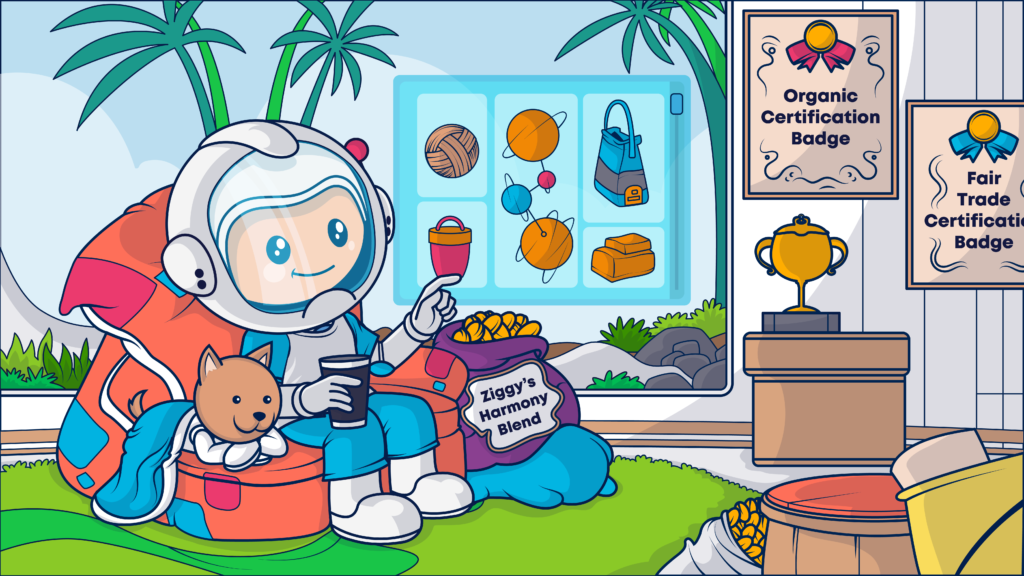
Since most of the time, what contributes to a better society also contributes to a healthier environment, there’s a lot of overlap between sustainable and green marketing. The difference between the two is that sustainability can have a broader remit–addressing issues related to the environment, sustainability or corporate governance.
Green marketing campaigns present a business’s products, services and actions related to environmental concerns such as reducing greenhouse gas emissions (GGE), stopping pollution, recycling, waste reduction and other practices perceived to have a direct impact on the health of the planet.
Meanwhile, sustainable marketing may focus on these concerns plus issues such a business’s diversity, equity and inclusion practices, how and where it sources ingredients, and its general behavior as a global corporate citizen.
Because of its broader scope, a marketing campaign can address sustainability issues without being green marketing.
The following set of emails includes examples of lifestyle, wellness and sustainable marketing messages not focused solely on environmental concerns.
📧 Global goods supplier Novica includes a values statement in every message.

📨 Just Add Color – India Holi Sale on now!
At the bottom of every NOVICA newsletter is a statement that says,
“Our customers have helped us to send for $128 million to artisans around the world. Impact the artisan causes closest to your heart with every purchase you make.”
In the email template’s footer is a brief mission statement, “At NOVICA, happiness is our mission, and love is at the core.” There’s also a link that takes subscribers to the “ten choices and one core value” that guide the brand.
💡 Use specificity to increase your purpose-driven message’s credibility and its emotional impact.
NOVICA’s copy doesn’t just tell subscribers they’re doing good, it quantifies their impact. The message assigns a real dollar value to the purchases customers make and explains who those purchases benefits.
📧 Orly nail polish lets its cruelty-free stance shine.

📨 ⏳Last Chance to Save on Great Escape! – Get one FREE bottle before it’s too late! ⚡️
This promotional email from Orly features bold images of its “Great Escape” collection of nail polishes. But saves some room at the bottom to add its values badges. Included in the selection are symbols indicating that the brand is vegan friendly and against animal cruelty (that’s what the rabbit image represents).
A beaker symbol tells customers that the polishes are “formulated without harmful ingredients” and another symbol tells them that these items are made in the United States.
💡 Graphical elements such as icons, vector images or emojis in your emails help convey concepts and emotions quickly. Accompany your graphics with text so that your meaning is clear. Use this added copy as an opportunity to add value by educating your audience.
📧 Thrive Causemetics shares an individual cause plus a few other values.
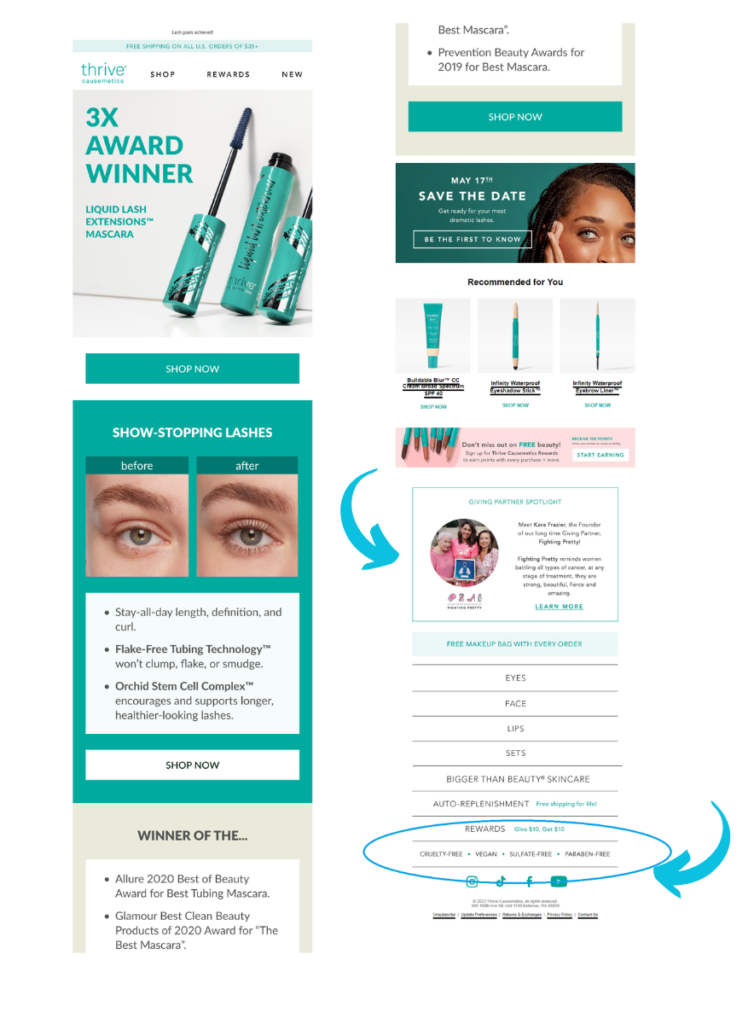
📨 Maximize Your Lash Length – Lash goals achieved!
As you might have guessed from this cosmetic brand’s name, Thrive Causemetics, the business supports charitable causes such as Fighting Pretty, the non-profit highlighted in this email message below the product promotions.
In addition to a callout with details about Fighting Pretty and a link for subscribers who want to learn more, this email also notes the brand’s other values in a panel above the email’s footer.
This section notes that the business is cruelty-free, vegan, sulfate-free and paraben-free–good for animals and the environment.
This email is an example of how your brand can appeal to LOHAS consumers and differentiate your products from similar goods in your category.
What do conscious consumers want from businesses?
In an article for the Network for Business Sustainability, author Heeseung Kim explains that conscious consumers seek ways to have a positive impact on their world through their behaviors and by voting with their dollars.
Leveraging their influence through their spending habits, explaining their values with friends and family, and sharing information about the causes they care about online, conscious consumers gain a sense of empowerment and facilitate real change.
Conscious consumers want to shop with businesses that share their values. To do this, they want businesses to be transparent about their environmental, social and governance (ESG) practices.
Conscious consumers expect authenticity, too.
Businesses that misrepresent their actions or dedication to the causes important to their audiences can find themselves embroiled in PR crises and consumer boycotts. Attempts at virtue signaling and greenwashing won’t slip past customers invested in doing the right thing and such deceits are not likely to be forgiven.
To satisfy conscious consumers, businesses must:
- Demonstrate that their values align with those of their target audience.
- Walk the walk by engaging in real, social and/or environmentally conscious practices.
- Give consumers information that enables them to make deliberate decisions.
- Deliver products and services that benefit the customer personally and have a positive impact on the issues that matter to them.
How large is the conscious consumer market?
The market for sustainable goods and services is increasing each year as shoppers become more aware of sustainable issues and more concerned for their own well-being.
📊 In 2021, Pew Research Center reported that 72% of people living in North America, Europe and the Asia-Pacific region now believe that they will be harmed by the effects of climate change at some point during their lifetimes.
📊 Consultancy Simon-Kucher surveyed more than 11,500 global citizens for its report finding that 66% of consumers rank sustainability as one of the 5 top purchase decision drivers.
📊 A separate survey by IBM found that purpose-driven consumers represented 44% of all global consumers, the largest segment identified by the study. Value-driven consumers, for whom ESG issues are secondary to price and convenience, made up another 37% of all consumers.
It’s worth noting that not only are conscious consumers a large market segment but also a segment willing to pay a premium to support their beliefs.
The IBM survey found that 50% of consumers across income levels will pay a premium for sustainable brands. Sixty percent of those surveyed would pay a premium for products or services offering greater health and wellness benefits.
How are businesses responding to consumers’ climate concerns and desire for values alignment?

As the number of ethical, conscious or purpose-driven shoppers increases, businesses have taken note.
Organizations are publicly disclosing their ethical and sustainable business practices on their websites and through other channels. Keep your cross-channel messaging consistent to spread your sustainable campaign message faster and build trust.
Some companies are transforming their organizations into purpose-driven businesses pursuing practices that benefit people and the planet as well as profits. Businesses in a range of industries have fully committed to a purpose-driven path, earning a B Corporation certification.
Non-profit organizations and government agencies are facilitating these new behaviors among consumers and businesses in an effort to slow the global climate crisis.
Helping brands communicate their values are new badges and certificates similar to the commerce-related trust signals shoppers are used to looking for.
Leaping bunnies, sunbeams, leafs and circles (to represent the circular economy) are all symbols of this revolution in consumerism that you may spot on websites or shop windows and in marketing emails.
The circular economy, btw, refers to a system in which the materials used to make goods are reclaimed and reused rather than discarded. In a linear economy, raw materials are consumed to make goods with the expectation that those goods will eventually be discarded and the materials used to make them lost. Circular economies employ upcycling, renting and repair, as well as recycling to reduce waste.
The image below includes examples of some of the different values-related badges consumers may find when visiting websites or viewing emails from their favorite brands.
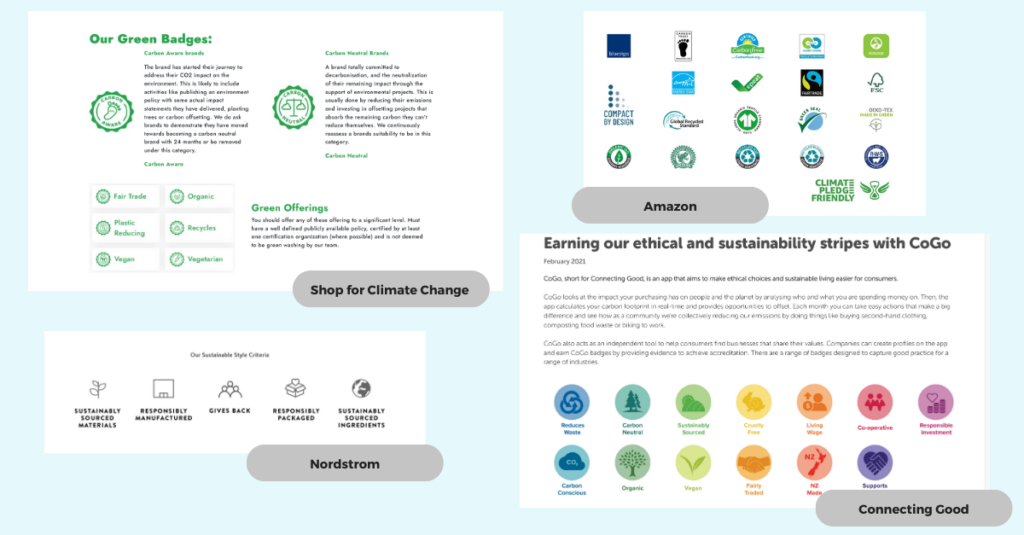
These badges and certifications aren’t the only way brands are promoting their conscious credentials.
Press releases, partnerships and sponsorships, community activations, commercials, social media activism and email marketing are all part of the mix when it comes to sustainability and green marketing.
⚠️In May of 2023, the European parliament was negotiating the details of rules to limit the types of environmental and sustainable claims brands could make. Check the laws of the jurisdictions in which your company operates and your subscribers reside when defining how you’ll communicate your sustainable practices.
How are brands incorporating sustainable messaging into their email marketing campaigns?
I curated this collection of emails made to appeal to conscious consumers just for you.
15 examples of sustainable marketing emails made to attract, educate and inform conscious consumers
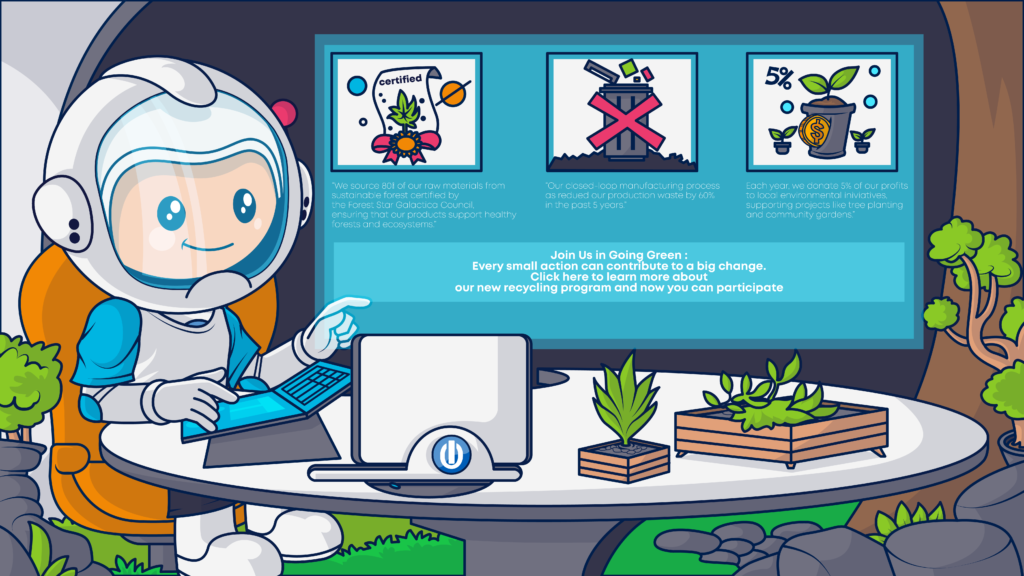
Just like your other email campaigns, your sustainable marketing campaigns can take a variety of forms. Use your sustainable campaigns to direct your subscribers to information on your website, engage with your brand community, follow you on other platforms such as YouTube, and choose your products or services when they’re ready to purchase. Maintain your sustainable messaging throughout your subscribers’ relationships with your brand by sharing your purpose and values before and after the first sale.
In the examples below you’ll find messages that are informational and promotional, as well as some that combine a little of both.
Examples of educational sustainable email marketing campaigns
This first selection of emails includes selections that talk about the sender’s sustainable behaviors or educates customers about how they can live (and shop) more sustainably.
Communicating the details about your business’s sustainable practices increases your credibility. Plus, you’re helping increase your subscribers’ knowledge about the issues that are important to them.
Cost and lack of selection are the top two reasons consumers don’t adopt more sustainable lifestyles. But a lack of information is another leading cause.
“Brands aren’t making it easy for consumers to purchase in a sustainable way,” observes the NielsenIQ 2023 consumer packaged goods sustainability report, citing a lack of options and unclear or confusing information among the causes.
📧 Wearwell delivers guilt-free advice for sustainability minded subscribers.
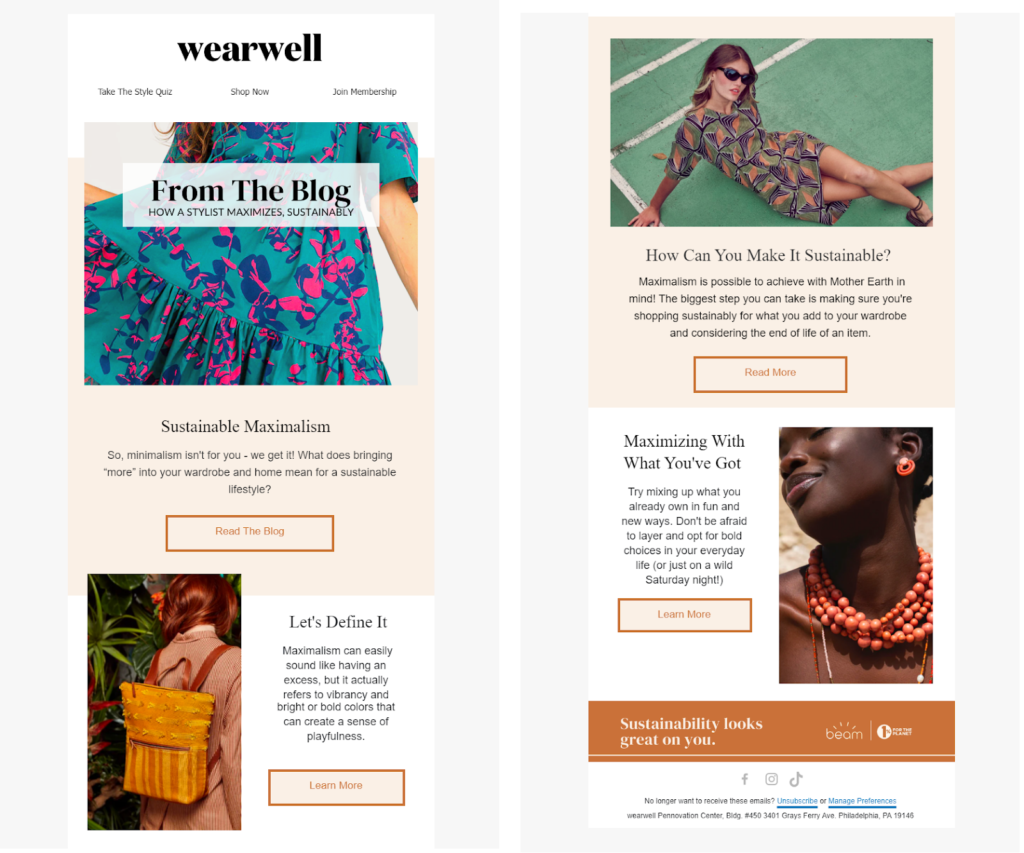
📨 Get the Look: Sustainable Maximalism – Sustainable Maximalism
This email is filled with positive encouragement to do sustainability your way–even if that means not keeping your wardrobe trimmed to the minimum. “Maximalism can easily sound like having an excess, but it actually refers to vibrancy and bright or bold colors,” notes the copy.
A second tip adds, “Maximalism is possible to achieve with Mother Earth in mind! The biggest step you can take is making sure you’re shopping sustainably for what you add to your wardrobe and considering the end of the life of an item.”
Attractive images of people wearing different clothing and accessories punctuate each tip. A color palette of tans, browns, and golden yellow and green further complements the theme.
The CTAs vary but all of them direct the reader to the same featured blog article.
An above the footer panel includes the tagline, “Sustainability looks great on you,” and Wearwell’s sustainability symbols.

Clicking on the ‘sunbeam/1% for the planet’ icons (next to the tagline) takes subscribers to the brand’s values statement page where it describes its sustainability and other purpose-driven efforts.
📧 Stumptown Coffee Roasters puts real numbers behind its sustainability claims in a newsletter updating subscribers on its progress.
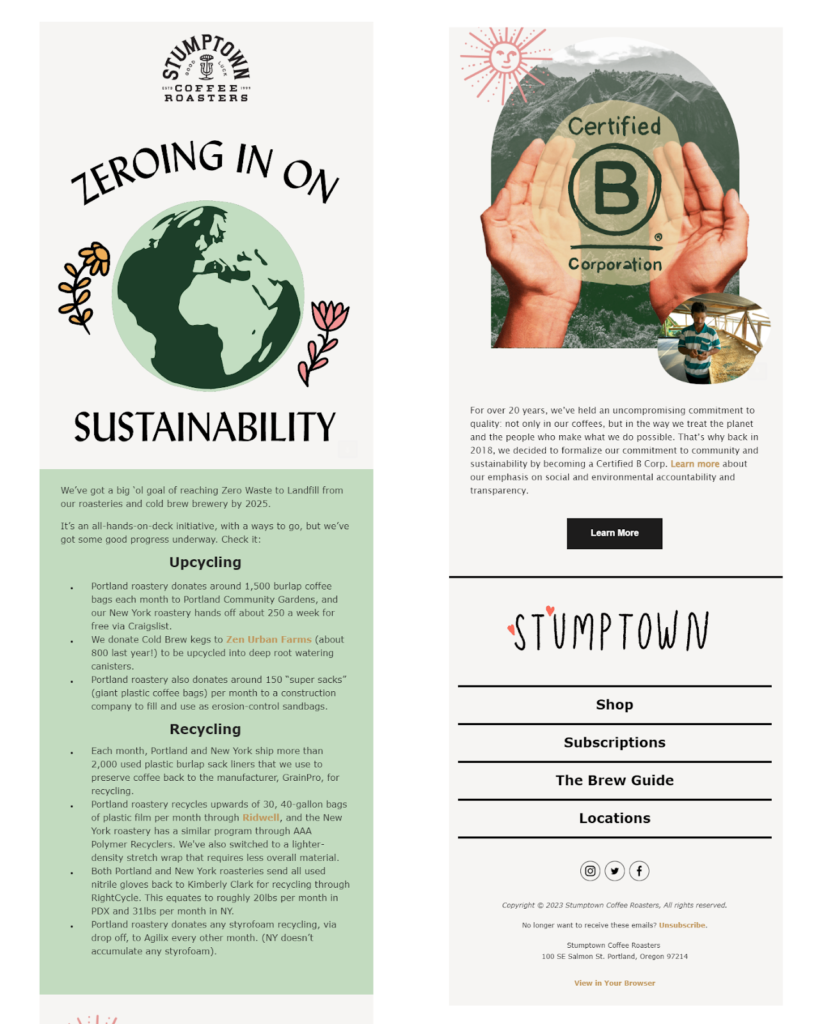
📨 Sustainability goals? You bet! – See how we’re working toward a zero-waste future.
Sustainability and corporate responsibility signals may soon overtake traditional trust signals as consumers seek to shop from brands with which their values align. Among the leading signals that say, “we’re the good guys,” is B Corporation certification.
Stumptown Coffee sent its subscribers an email newsletter showing off its B creds and updating them on its sustainability efforts. Yes, they used green as a focus color.
The newsletter includes details about several specific actions the business has taken to upcycle, recycle and reduce its impact on the planet. Send your subscribers a mix of promotional, educational and community-themed content in your newsletters to add value and support deeper relationships.
Stumptown made sure its readers knew that it wasn’t just hopping on the latest trend with this email. The closing paragraph of this sustainability report reads,
“For over 20 years, we’ve held an uncompromising commitment to quality: not only in our coffees, but in the way we treat the planet and the people who make what we do possible. That’s why back in 2018, we decided to formalize our commitment to community and sustainability by becoming a Certified B Corp.”
The message and button CTA then invite readers to learn more about the brand’s efforts.
Authenticity and the proof to back your claims are an important element in sustainability marketing. Brands can’t just talk the talk. Make sure you can show that you walk the walk when creating your sustainability campaigns.
📧 Snack maker KIND touts its latest eco-friendly initiative and invites subscribers to participate.
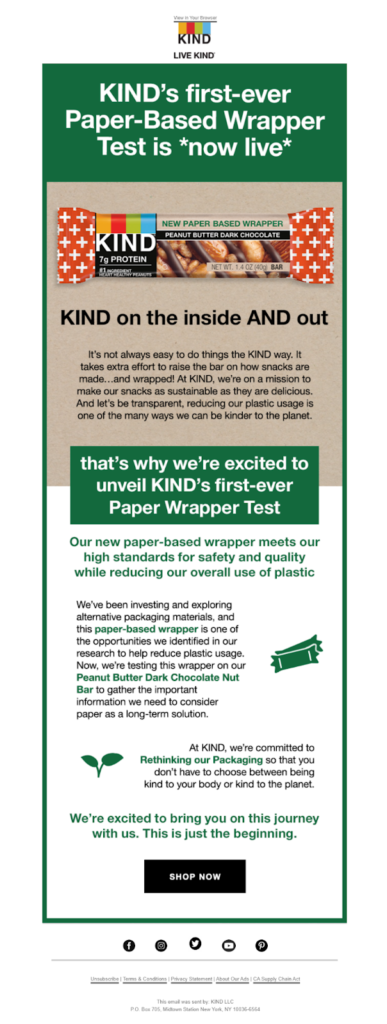
📨 KIND’s first-ever Paper-Based Wrapper Test is ✨now LIVE✨ – KIND on the inside AND out!
Nothing says eco-friendly like a green color scheme. This email from KIND communicates its green credentials with deep green banner backgrounds and text accents. The green leaf sprout graphic near the bottom of the message is another fast visual clue.
The copy of this message tells the full story, though, and hints at how subscribers can support the brand’s sustainability efforts. The snack bar featured in the hero image is being sold in a new paper-based wrapper.
The email’s copy explains that the wrapper is being tested with consumers after it passed internal safety and quality standards.
Emphasizing the significance of the event, the message further explains,
“It’s not always easy to do things the KIND way. It takes extra effort to raise the bar on how snacks are made… and wrapped! At KIND, we’re on a mission to make our snacks as sustainable as they are delicious.”
That green sprout directs readers to the closing copy that says, “At KIND, we’re committed to Rethinking our Packaging so that you don’t have to choose between being kind to your body or kind to the planet. We’re excited to bring you on this journey with us. This is just the beginning.”
Did you notice all the emotional triggers in this email?
The brand empathizes with customers who want to do the right thing but need more options such as paper wrappers instead of plastic. The email’s messaging also conveys a sense of belongingness. Readers who purchase KIND products with the new wrappers are actively contributing to the brand’s efforts to reduce its use of plastics.
Check out our complete guide to email copywriting to learn more about using emotion to inspire action.
📧 Moonshot makes purpose a part of its personalized pitch.
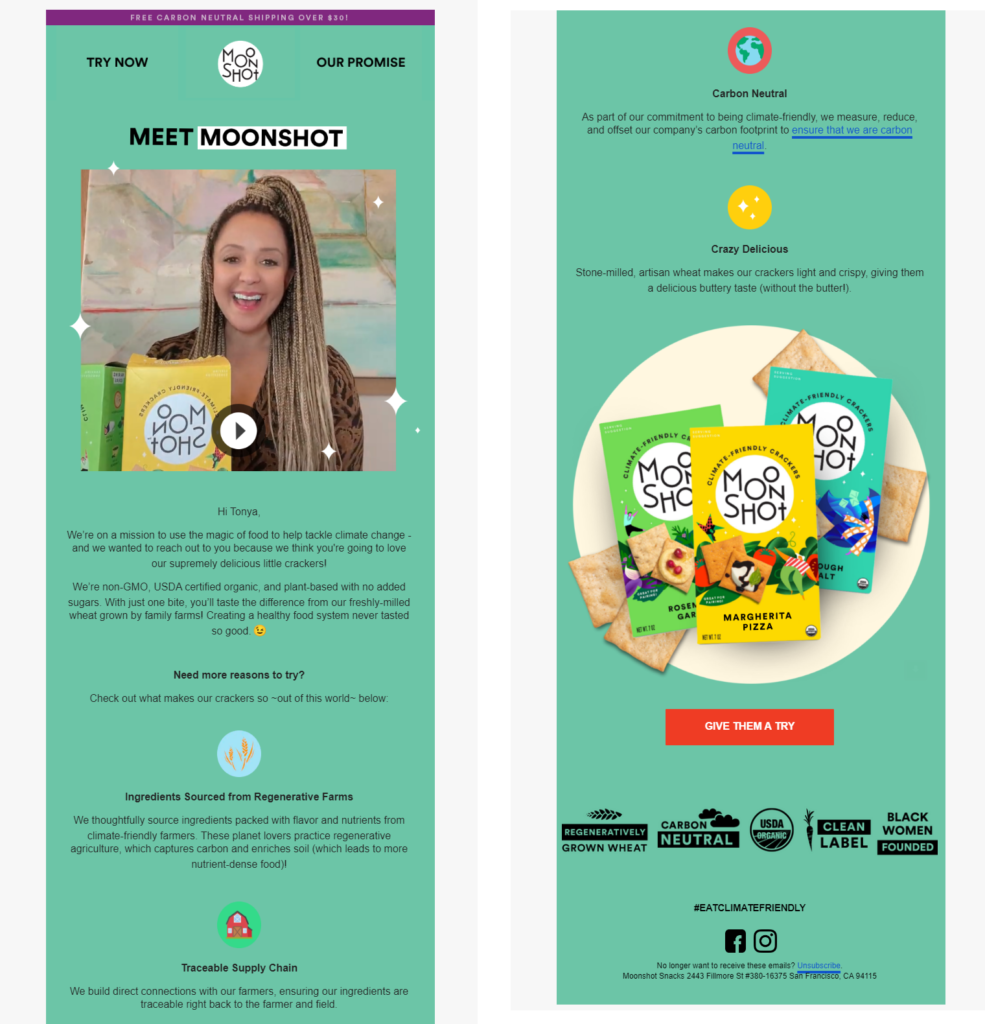
📨 {{First_Name}}, help us fight climate change! – one tasty snack at a time ✨
Snack maker Moonshot’s colorful email is packed with reasons consumers should choose Moonshot snacks. The top of the email features a graphic-link to a friendly video from the brand’s founder shot with a casual, authentic feel.
In the video, Moonshot’s founder explains the brand’s sourcing and climate-neutral practices and introduces its products.
The email’s copy reflects this same friendly and informative tone. Its introductory section includes the tagline, “Creating a healthy food system never tasted so good.”
Under separate headings, accented with colorful icons, the email explains details such as how the ingredients are sourced from regenerative farms, and how Moonshot uses traceable supply chains and carbon neutral offsets.
This message closes with the values panel I’ve come to expect with a row of sustainable and social conscious-related badges.
Emails like this one that promote and inform appeal to informed audiences who want to validate the brand’s practices and consumers who want brands to help them learn how to engage in more sustainable behaviors.
💡 Adding video content to your emails creates a new angle of interest. Videos featuring your company’s founders, team members or customers present the real humans behind the brand.
📧 NEOM announces its promotion to B Corp. status.
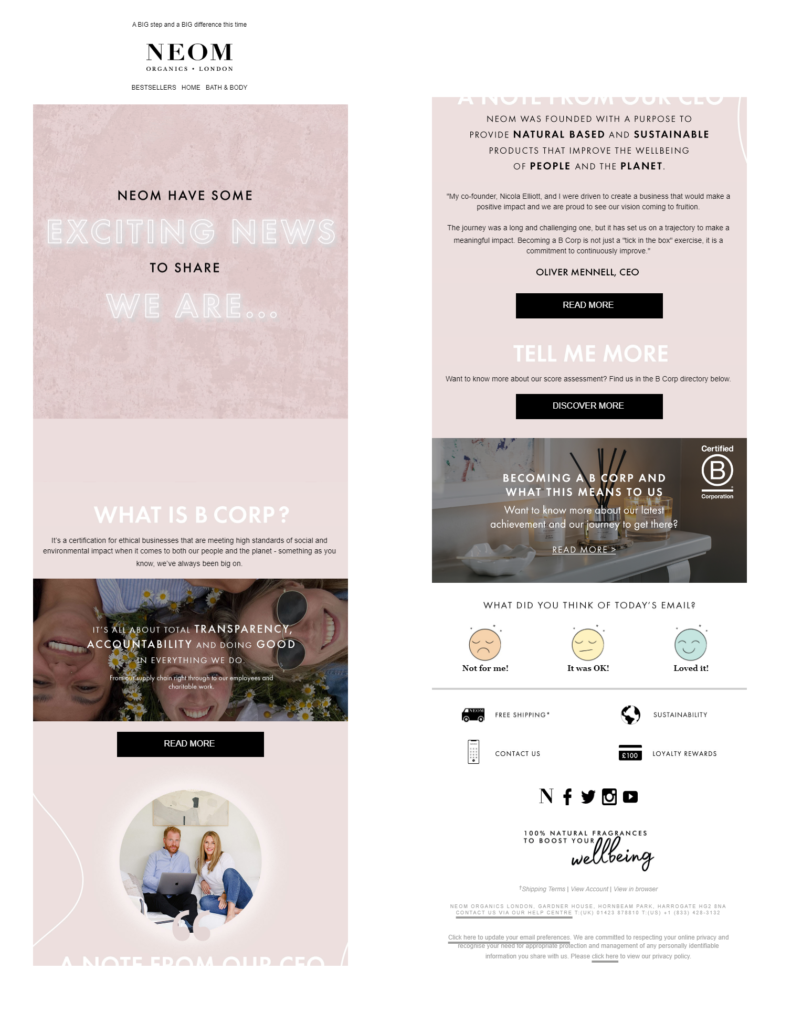
📨 OFFICIALLY A B CORP – A BIG step and a BIG difference this time
NEOM Organics offers a variety of self-care products and its primary message is one of personal well-being. The brand is perfectly positioned to appeal to LOHAS consumers. NEOM Organics demonstrates that it cares about bigger issues in this email message.
This broadcast message to subscribers announces the big news that it has achieved certification and educates subscribers about what it means to be a B Corporation.
A major company announcement is one of several situations where a mass email send is the best method to communicate with subscribers.
The close-up of its pre-footer panel below shows its newly attained B-Corp. badge on display.
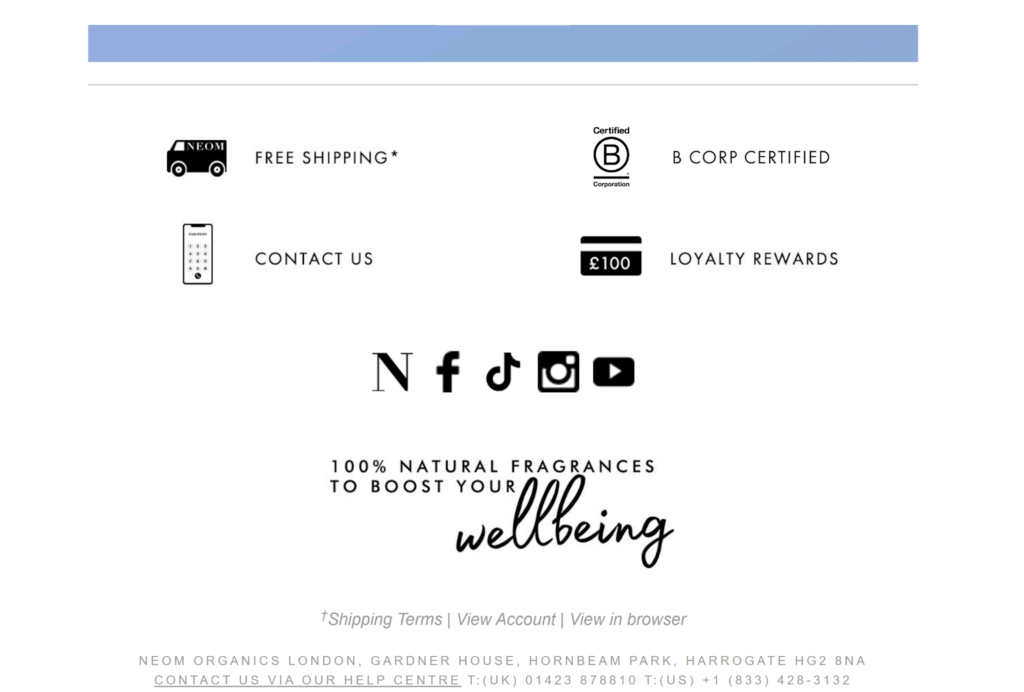
Explaining the significance of being a B Corporation benefits consumers by making them more aware of the ways in which brands prove their commitment. It benefits NEOM by setting it apart from brands that haven’t taken this step.
Email campaigns that promote win-win waste reduction
Next I have a set of sustainable marketing messages that offer subscribers a purchase-connected incentive to take action to reduce landfill waste. These messages help the senders increase sales while also burnishing their reputations as friends of the Earth.
📧 John Paul Mitchell Systems sends a bulk email inviting subscribers to reduce the electronic waste sent to landfills.
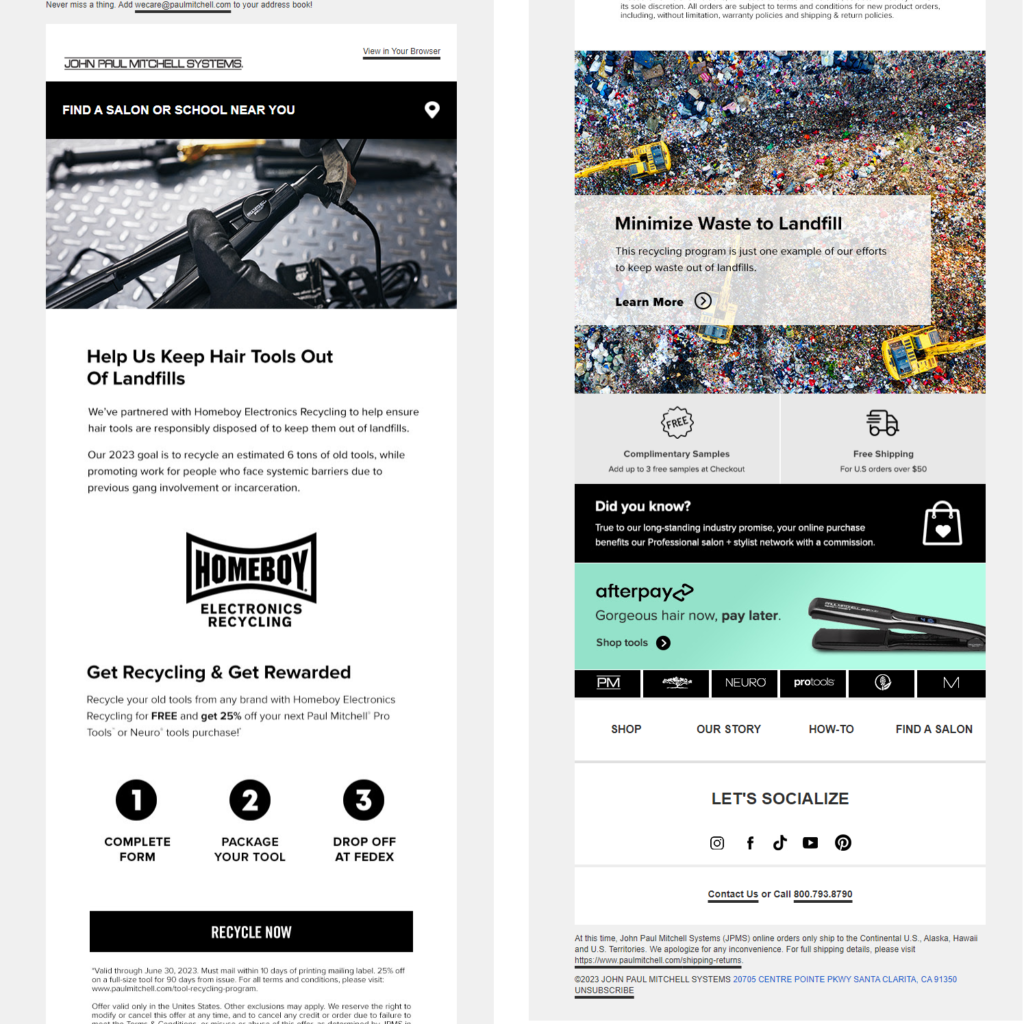
📨 ♻ Recycle + Save 💰 – 25% off when you recycle your old broken hair tools.
The subject line and preview text of this email from salon hair care brand John Paul Mitchell Systems tell subscribers exactly what the email is about and what’s in it for them. They can contribute to sustainability and save money.
The email announces a limited-time partnership between the brand and a program called Homeboy Electronics Recycling. In addition to explaining why John Paul Mitchell Systems is supporting this program, the email outlines the steps subscribers can follow to participate.
Making it easy for everyone to take part, this program allows people to send in their used hair care tools free via FedEx and get a discount on something new.
Below the instructions for this help the planet promotion, is an image of a landfill.

Following a header that says, “Minimize Waste to Landfill,” the overlay text continues,
“This recycling program is just one example of our efforts to keep waste out of landfills.” The simple text accompanied by an arrow invites subscribers to visit the website to, “learn more.”
Including images of the devastation caused by excessive waste or other environmentally damaging activities can motivate subscribers to act.
But don’t overdo the drama Kat Brandt advises in the Think with Google article, 3 sustainability marketing pitfalls — and how to turn them into wins. Dire warnings may overwhelm consumers, making them feel powerless to make a difference.
📧 Arc’teryx outdoor wear offers an extra incentive to trade in unused gear.
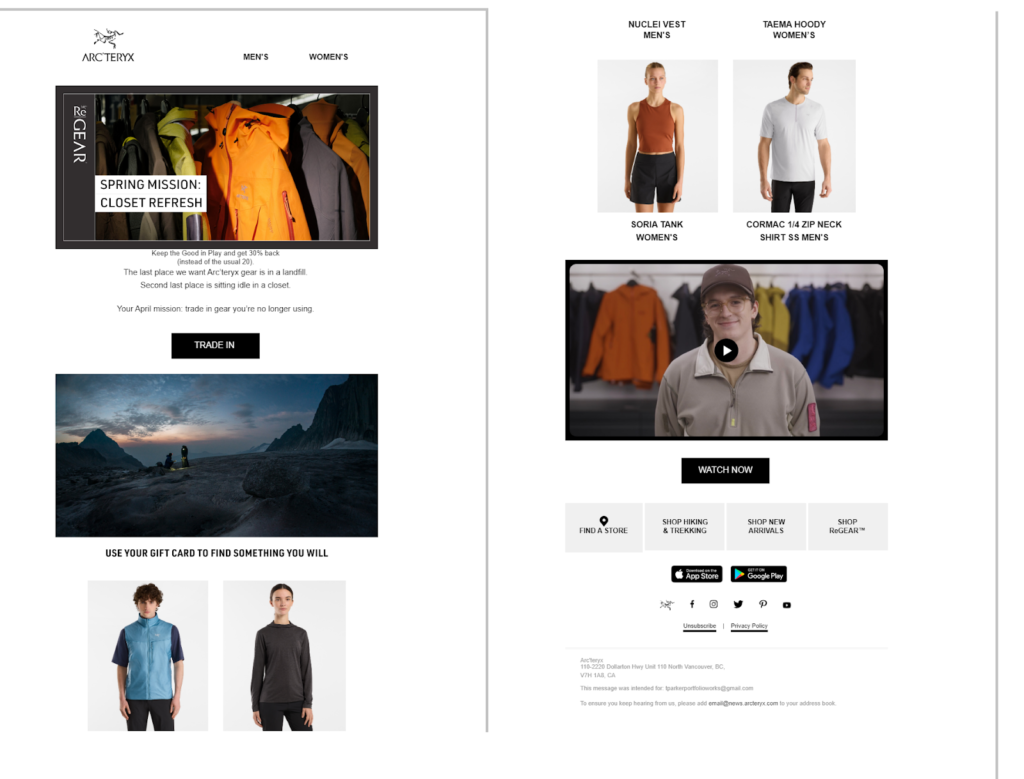
📨 Get 30% Back on All ReGEAR Trade-ins – This April only.
Arc’teryx promotes its sustainable efforts and invites subscribers to participate in this email that offers them a bonus for trading in their used Arc-teryx gear during the month of April. Calling it a “Spring Mission,” the email says,
“The last place we want Arc’teryx gear is in a landfill. Second last place is sitting idle in a closet.”
An above the fold CTA button then gets straight to the point, with the copy: “Trade In.”
Small but mighty, this CTA uses just two words to encourage subscribers to take a specific action. Don’t overlook opportunities like this to use your CTA copy to move consumers forward and reinforce your email’s message.
Hinting at what’s at stake, the next image in this email is an outdoor shot featuring a beautiful top of the mountain view. The email covers the “what’s in it for me” angle, too, by recommending some items customers can purchase with their trade-in gift card credits.
Perhaps the best part of this email though is the linked video. The static image for the video promoting Arc’teryx’s ReGEAR trade-in program features a smiling member of the Arc’teryx gear repurposing team, putting a human face to the brand and its cause.
Email recipients who click-through will see a full length video that uses personable, witty scripting and real-world action to introduce them to the ReGear program and more team members.

Arc’teryx uses an email newsletter to drive traffic to a YouTube video that highlights its trade-in program for branded gear.
Including real data about the impact the program has on reducing downstream waste shows viewers that their individual efforts can make a difference.
It’s important to avoid hypocrisy or blame shifting when asking your audience to contribute to sustainable causes. This video educates consumers without being judgemental and acknowledges the role Arc’teryx and other fashion brands play in filling the world’s landfills.
Strive for a cooperative, “we’re all in this together” tone to encourage and empower your subscribers.
Examples of brands promoting their sustainable purposes along with their products
The following selection of sustainable marketing emails that subtly share their purpose with conscious consumers but don’t make sustainability the focus of the campaign. These messages are an example of messaging that makes eco-friendly purchasers normal and the default choice.
📧 The Earthling Co. subtly shows off its sustainable credibility.
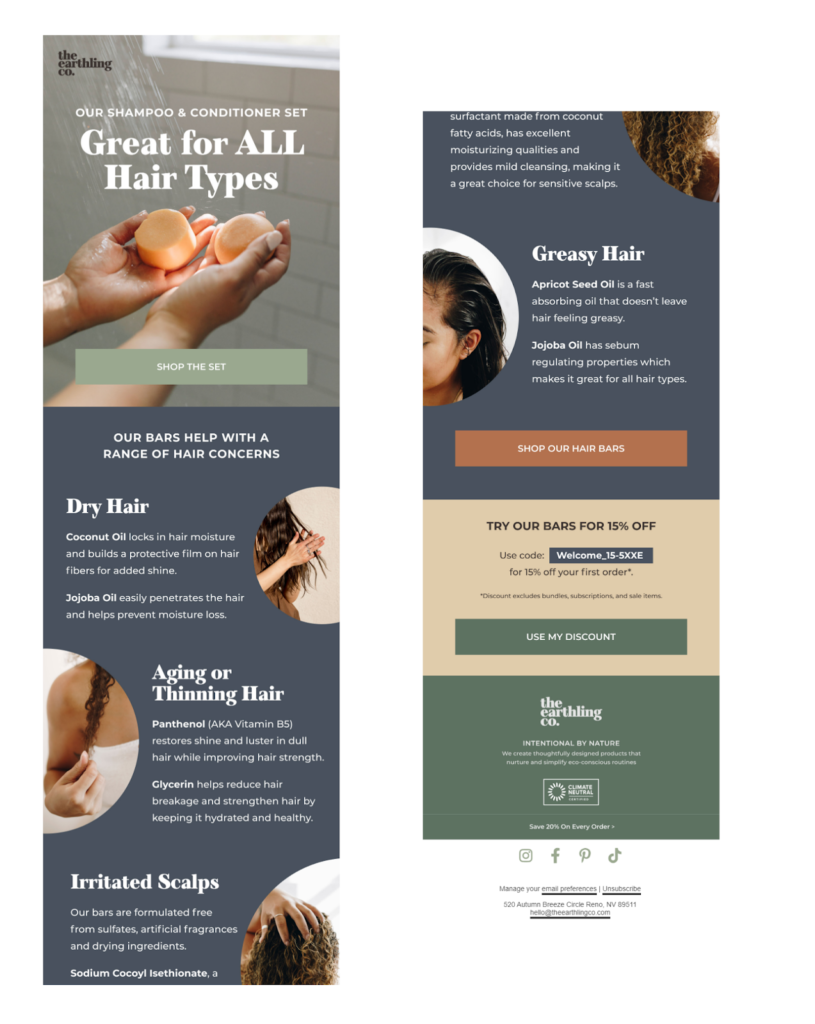
📨 Do you have Hair Concerns? We’re addressing them →
With a name like, “The Earthling Co.,” it’s a pretty safe bet that this hair and personal care company is environmentally keen and green. But that doesn’t mean green marketing is the only type of messaging the brand does.
They still have products to sell!
This product recommendation email introduces subscribers to several products and educates them about the uses and benefits of each one.
“Our shampoo and conditioner set Great for ALL hair types” is the email’s header pitch.
Through the email, the copy references natural ingredients and their benefits without playing up their “green” factor. The hints are there, though.
This email template uses a nature-themed color palette of toned-down blues, greens and tans.
Just in case subscribers didn’t get that The Earthling Co. has a thing for the planet, its above-the-footer panel sets them straight.

Under the brand’s tagline, “intentional by nature,” the copy says,
“We create thoughtfully designed products that nurture and simplify eco-conscious routines.”
This statement is followed by a “Climate Neutral Certified” badge that bolsters the company’s eco-credibility.
📧 Purpose-driven clothing brand PANGAIA sends a product-focused welcome email that also explains the brand’s values.
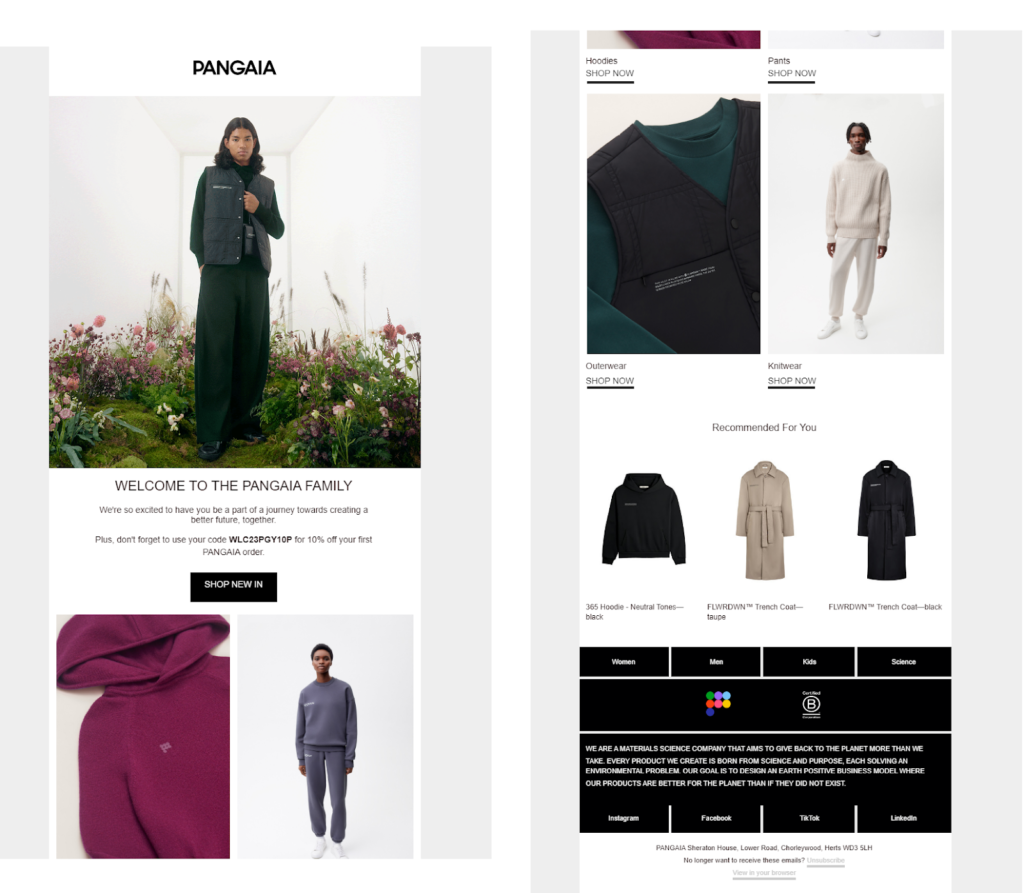
📨 Enjoy 10% off your first purchase – Welcome to the PANGAIA Family
Like other brands that pursue the triple bottom line of planet, people and profit, PANGAIA doesn’t lead with sustainable messaging when greeting subscribers. Its welcome email subject line and preview text follows a standard welcome email pattern, offering new subscribers a first-purchase discount and conveying a sense of belongingness.
Inside the email, an animated GIF hero section shows various models posing amidst moss and flowers (so green) wearing different pieces from the PANGAIA collection.
After welcoming new subscribers to the family, the email’s copy emphasizes the brand’s value and continues the community theme.
“We’re so excited to have you be a part of a journey towards creating a better future together,” the copy says.
Notice the use of participatory language?
No guilt, just good vibes about doing good together.
The focus of this email then shifts back to earning clicks and conversions with a welcome coupon code and a “Shop New In” CTA button. Additional “Shop Now” CTAs accompany a mix of images of the brand’s fashions.

PANGAIA also adds its B Corp. badge to its email template along with its values statement which says,
“We are a materials science company that aims to give back to the planet more than we take. Every product we create is born from science and purpose, each solving an environmental problem. Our goal is to design an earth positive business model where our products are better for the planet than if they did not exist.”
PANGAIA’s focus on effective use of materials is a unique position that differentiates it from other sustainable brands, making it worth mentioning in every email.
📧 Aurate New York promotes its jewelry and publishes its credentials.

📨 30% OFF TO THRILL THE SOURCE OF ALL LIFE – Budget? What budget?
Edgy but eco-conscious jewelry brand Aurate New York’s website states that it uses recycled gold, ethically sourced diamonds and sustainably harvested pearls to produce its jewelry. The brand also publishes a report detailing its charitable giving on its site.
But in this seasonal promotion for Mother’s Day the jewelry and deals are the star attractions. A gold and ivory color scheme and lots of product close-ups plus a section packed with social proof encourages subscribers to “make mom proud” (and order in time to get delivery before her special day).
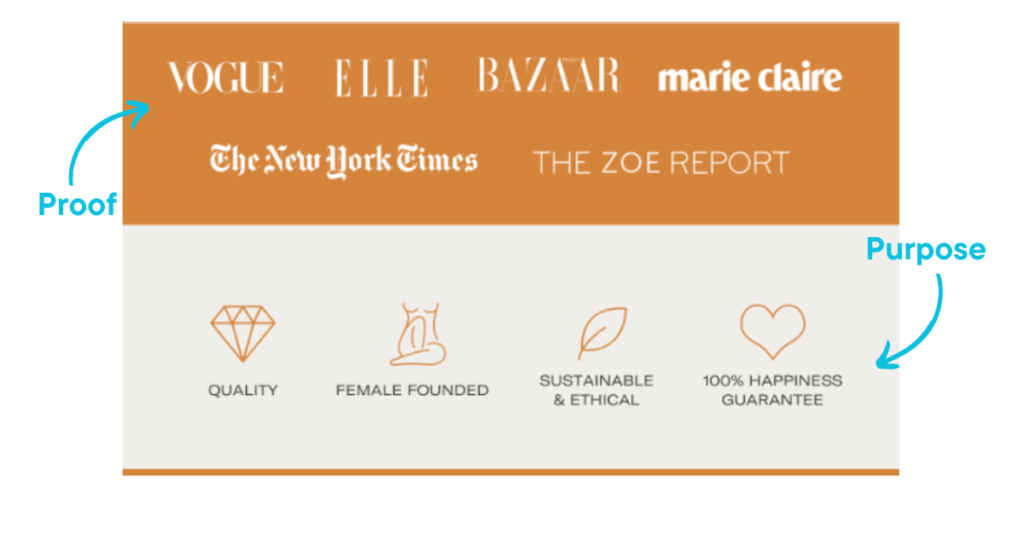
Below a section that names some of the popular magazines and other publications that have mentioned the brand is a values bar which includes icons representing the brand’s commitment quality, customer satisfaction and sustainable and ethical practices. This section also highlights that the brand is “female founded” as part of its purpose-driven messaging.
📧 Cuyana promotes the sustainable attributes of quality products.
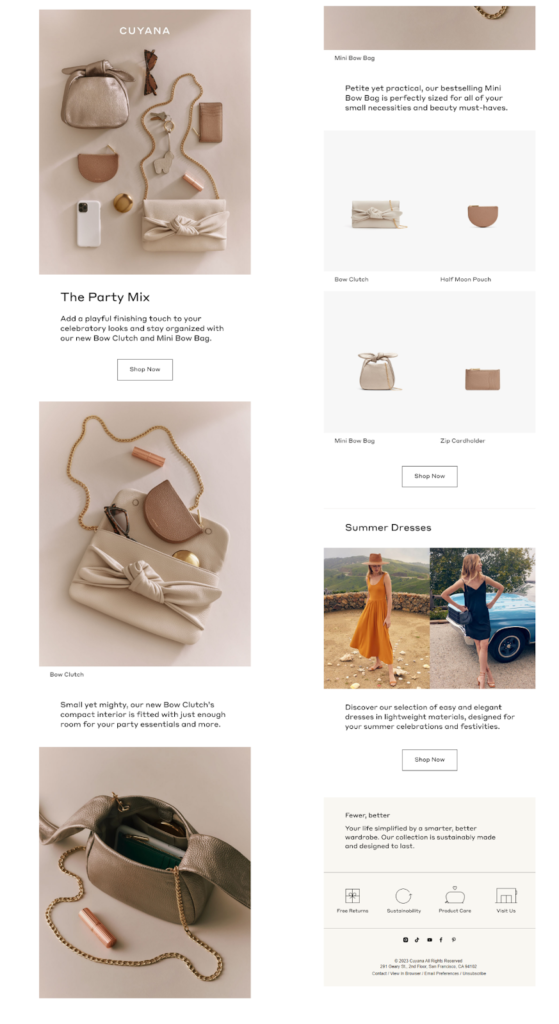
📨 Get Ready to Party with New Bow Bags – A look inside our smart yet mighty mini bags.
This product-centered newsletter from fashion and accessory brand Cuyana uses its above the footer panel to note that its durable, classic pieces are good for customers and the planet. The copy below the heading “Fewer, better,’ says,
“Your life simplified by a smarter, better wardrobe. Our collection is sustainably made and designed to last.”

Exemplifying its dedication to durability, the graphic-linked icons below this message direct subscribers to a sustainability statement on Cuyana’s website and a product care guide.
💡 Increasing the useful life of an item through the use of durable materials and manufacturing processes, facilitating repair and reconditioning of items, and supporting the resale of goods is a core component of a circular economic model.
Email campaigns that include products or perks that naturally appeal to conscious consumers
The emails below are from brands presenting products or bonuses conscious consumers will find attractive.
📧 OUI the People offers a sustainability-supporting perk as part of its regularly scheduled promotions.
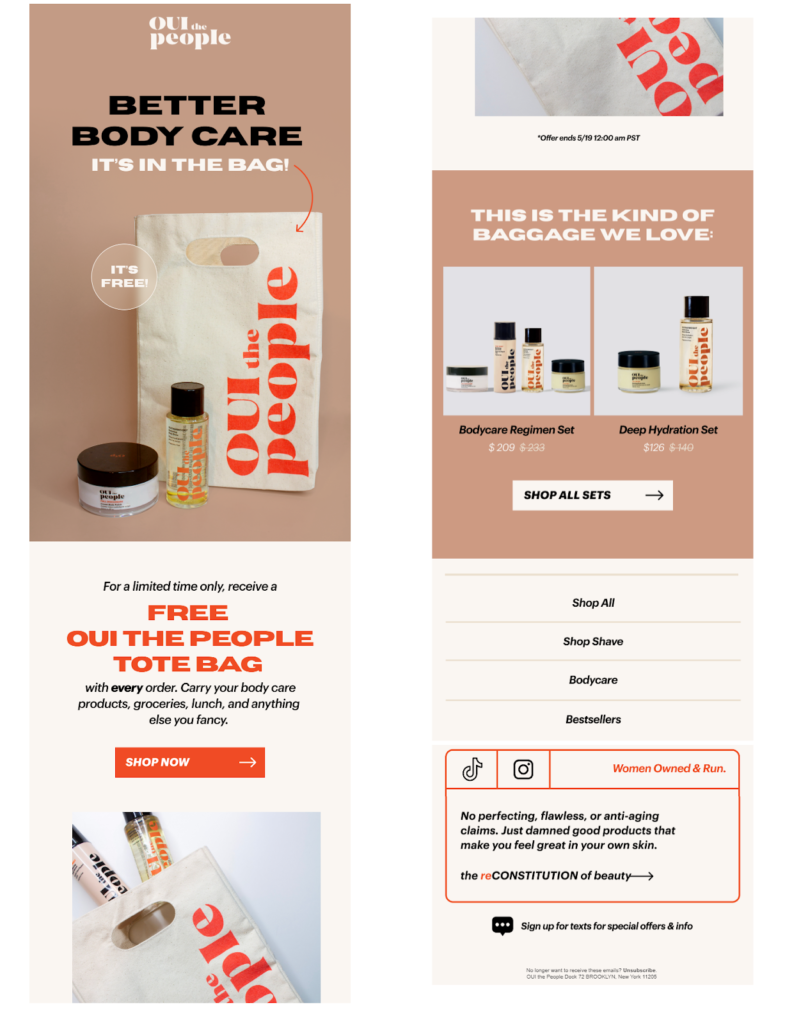
📨 Take Us with You! – Free Tote with Every Order
Sustainability and eco-friendly practices don’t have to be the primary theme of your marketing email–or even mentioned in it–to appeal to environmentally conscious consumers.
Whether your brand is fully purpose-driven or just doing its part when it can, you can still promote practices and offer incentives that contribute to sustainability and please your customers.
This offer in this email from OUI the People is an example of a promotion that promotes taking care of the planet without saying so. Offering purchasers a free reusable tote encourages them to cut down on single-use shopping bags and makes them feel like they are getting extra value from their purchase–and it’s an easy-to-implement attraction marketing tactic.
📧 Food52 helps subscribers find products that help them meet their needs and care for the earth.
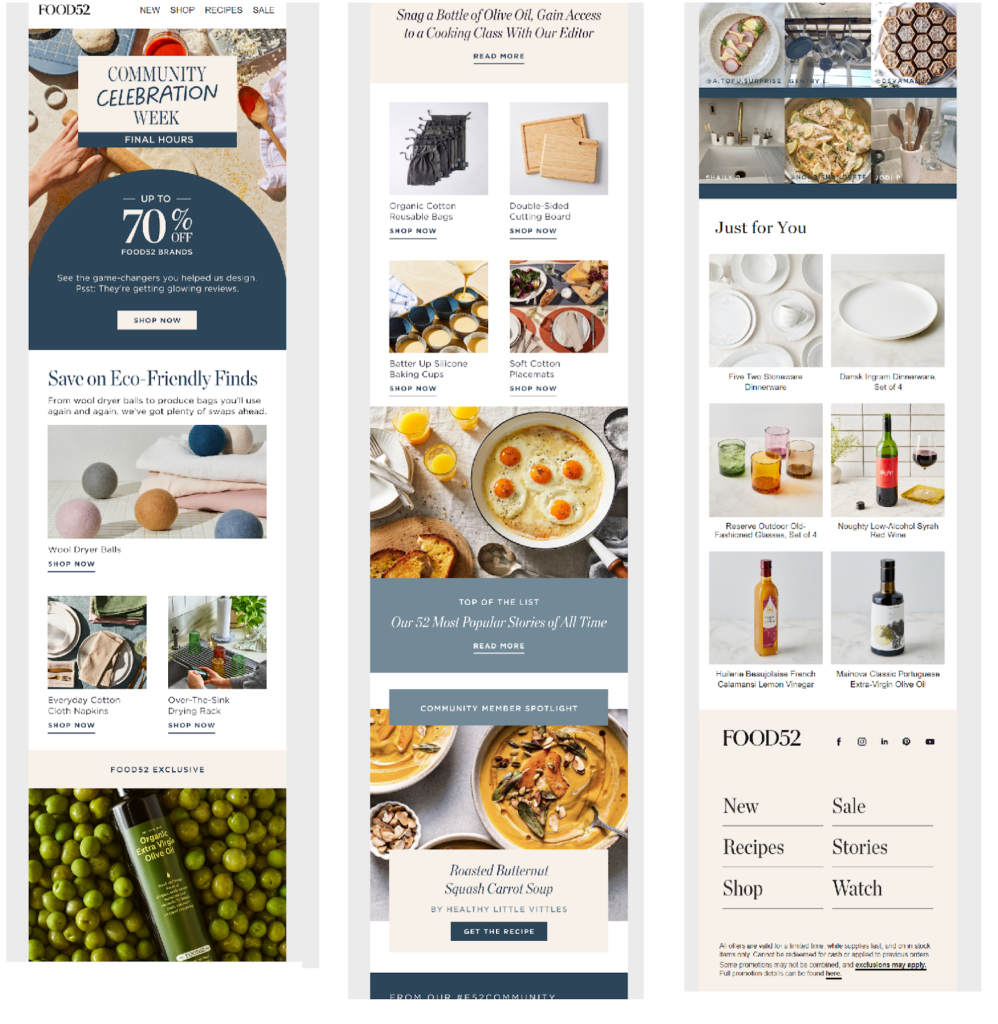
📨 Final hours! Save on our home game-changers. – Up to 70% off is almost gone for good.
This promotional email newsletter from Food52 aims to attract opens and clicks with a value-driven appeal in the inbox. The subject line and preview text promote urgency and savings.
Inside the email, the retailer offers value- and purpose-driven consumers something to appreciate.
The email’s header and hero image announce that the promoted products were suggested by the brand’s community and on sale for prices up to 70% off.
The secondary header appeals to conscious consumers, encouraging them to, “Save on Eco-Friendly FInds,” such as wool dryer balls and cloth napkins.
Not all the products in this newsletter that mixes recipes, product recommendations and links to blog content are promoted as eco-friendly. But the call-out heading communicates to customers that the brand is aware of their interest in sustainability.
Let your customers know about your sustainable product or service options, even if your business isn’t completely purpose-driven.
With many consumers open to opportunities to make sustainable choices, every marketing team should be looking for ways to present their sustainable products and actions.
Email marketing examples from purpose-driven brands promoting their products and causes
Finally, these examples of sustainable email campaigns from purpose-driven brands encourage consumers to do good while also getting the items they want.
📧 Athletic Greens marks World Health Day with a promotion about its purpose.
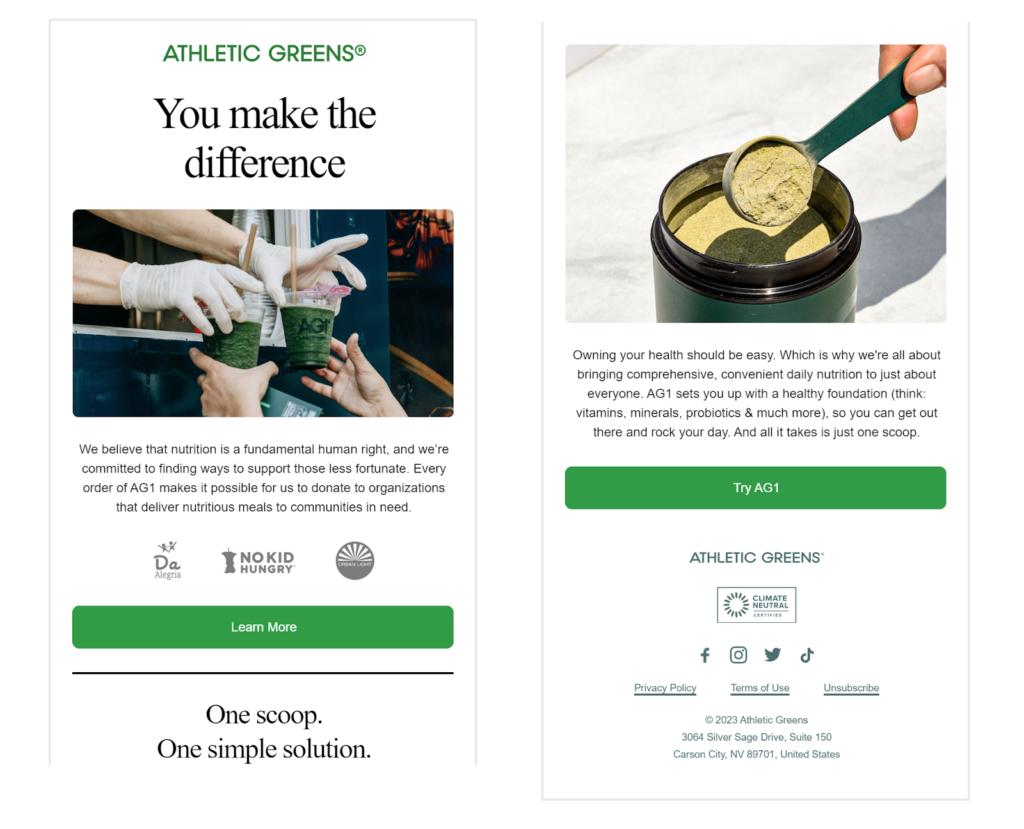
📨 Celebrating World Health Day today and every day – Doing good for yourself and the world
The theme of this email from healthy smoothie ingredient brand Athletic Greens is clear from the start. Its subject line and preview text set the tone for a promotion that enables customers to help others while helping themselves.
This email’s preview text is a good example of how to use preview copy to add context to your subject line and tell subscribers what to expect inside your email.
This email is an example of how sustainable marketing often intersects with and includes purposes beyond climate change. This email shares the brand’s belief that nutrition is a fundamental human right and explains how purchases of its products support donations to community food and nutrition organizations.
The second half of the email message focuses on the reader’s personal well-being, promoting Athletic Green’s daily nutrition solution.
The final touch for this promo that presents the brand’s values?
A Climate Neutral Certified badge centered above the social media icons and other footer content.
📧 Conscious Step chooses planetary purposes for its April newsletter.

📨 FOR THE PLANET 🌎 – Choose how you want to protect Mother Earth this Earth Month
Earth Day is celebrated in April every year. So many brands choose the month of April to launch environment-themed campaigns or update customers about their sustainable initiatives.
Purpose-driven sock brand Conscious Step was one of those companies.
The brand offers socks that support a variety of charitable causes and highlights them in its emails throughout the year. For example, their May email promotes mental health and a January promotional newsletter drew attention to animal welfare.
Conscious Step’s email for Earth Month features earth and conservation themed products and highlights some of the sustainable charitable organizations the brand partners with including Conservation International, Water.org and Trees for the Future.
While this email promotes Conscious Step’s products, it also connects its subscribers with eco-conscious organizations that they can learn about and support.
Including information about and links to organizations your brand wants to support and promote is similar to placing paid ads in your email newsletters–but for a good cause.

Sharing sustainable resources with your audience encourages and empowers those who want to do more about their environmental concerns but may not be sure where to start.
9 tips to super-charge your sustainable email marketing campaigns
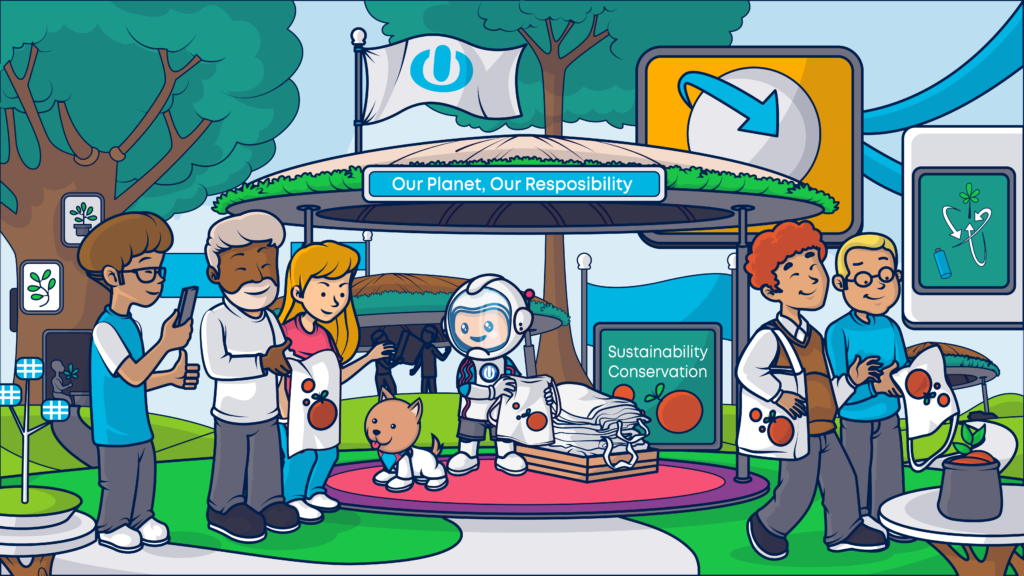
Since sustainable marketing has a broad scope, it presents many opportunities for businesses to show how their values align with their target audiences. Of course, there’s also room for a business to miss the mark when it comes to identifying what matters most to its customers.
Follow these tips and techniques to craft the perfect purpose-promoting email campaigns for your audience.
🌐 Understand your customers and their values before you embark on a green or sustainable marketing campaign. While most consumers have some level of concern about the environment and social issues, the degree to which that concern will affect their buying decisions varies. Analyze your audience data and use segmentation to tailor your message for subscribers with different concerns and preferences.
🌐 Value-driven consumers care about price and convenience. But they care about the environment, too. Frame your sustainability message to emphasize durability and quality and your value-driven customers will see that a sustainable purchase is a win-win.
🌐 Modern consumers already know the basics about climate change and sustainability. They want details. Explain your products or services contribute to the greater good and how their purchase decision can affect change.
🌐 Do not exaggerate your sustainability claims or attempt to claim virtues you haven’t earned. Consumers who research before buying won’t fall for greenwashing.
🌐 Encourage sustainable choices such as delayed shipping or bulk purchases, or even your premium priced eco-friendly goods over a cheaper option, by making these eco-conscious choices the default.
🌐 Don’t use sustainability as a trend you can follow or abandon whenever. Normalize sustainable purchases and make your sustainable stance an integral part of your brand to earn your conscious consumers’ trust.
🌐 Use community news, user generated content and testimonials to support your sustainability claims and encourage your customers to act.
🌐 Avoid inducing fear and guilt in your sustainable marketing messages. Don’t focus on what your customers can’t control, but what they can. Give them actions they can take and show them how those actions have a positive impact.
🌐 Build relationships with your subscribers by becoming a trusted resource for information about green best practices for your industry. Create specialized landing pages where your subscribers can learn more about your initiatives and find additional third-party resources and add links to these pages in the navigation section of your email templates.
As we enter a new era of global awareness and concern for health, well-being and the environment, more businesses recognize the value of pursuing a triple bottom line (people, planet, profit) strategy. Use your email campaigns to build stronger relationships with the conscious consumers on your list with information, encouragement and support.
Want to learn more about growing your business through building lasting relationships? Check out Employing Relationship Marketing to Increase Customer Loyalty and Lifetime Value.
Stay green!

